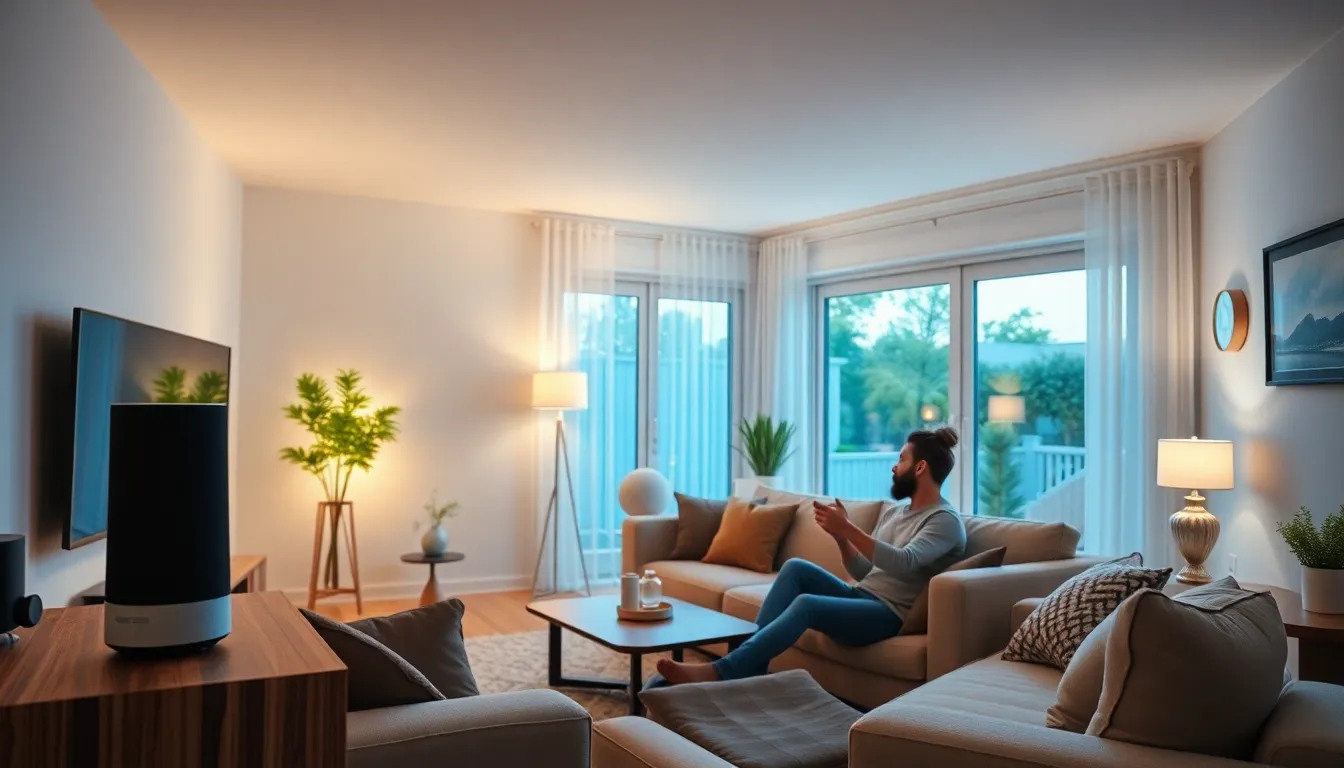Imagine waking up to the smell of freshly brewed coffee, your curtains gently parting to let in the morning sun, and your favorite playlist softly serenading you—all without lifting a finger. Welcome to the world of smart home automation, where even the laziest among us can feel like tech-savvy wizards.
Table of Contents
ToggleOverview of Smart Home Automation Ideas
Smart home automation enhances everyday living through a variety of technologies. Many people utilize smart speakers, allowing voice commands to control various devices. Automated lighting systems enable users to adjust brightness and colors effortlessly. Temperature control systems rank among the most popular options, optimizing comfort while reducing energy consumption.
Home security solutions include smart locks and cameras that provide real-time updates and remote monitoring. Users can receive instant notifications for unusual activities, ensuring peace of mind. Integrating smart appliances like fridges and ovens can streamline meal preparation, allowing seamless cooking experiences.
Consideration for scheduling adds another layer of convenience. Users can set routines for when to turn on lights or adjust thermostats based on their schedules. Security systems can be programmed to simulate occupancy, deterring potential intruders.
Entertainment systems also benefit from automation. Smart TVs and sound systems can connect to streaming services, enabling effortless content access and management. Users can create specific atmospheres with pre-set scenes for movie nights or social gatherings.
Energy management systems promote sustainability. Smart plugs help reduce waste by tracking energy usage and allowing users to control connected devices remotely. Homeowners can identify which devices consume the most energy, making it easier to cut back.
With a range of potential applications, smart home automation provides an array of benefits that simplify and enhance daily life. Each technology integrates seamlessly, creating a cohesive environment that promotes efficiency and comfort.
Benefits of Smart Home Automation

Smart home automation enhances everyday life through convenience and security. By integrating technology into daily routines, it simplifies tasks and promotes a comfortable living environment.
Increased Convenience
Smart home automation significantly increases convenience. Users control devices and appliances remotely, allowing them to manage lighting, temperature, and entertainment systems effortlessly. Device integration creates customized routines, so morning tasks such as brewing coffee or adjusting blinds happen automatically. Smart speakers enable voice commands for hands-free operation. Homeowners can schedule chores like vacuuming while they’re away. Energy-efficient devices adjust usage based on real-time data, helping to optimize efficiency. With smart notifications, families stay informed about essential activities or appliance statuses. Overall, automation transforms common household tasks into a seamless experience, freeing up time for more important activities.
Enhanced Security
Enhanced security is a primary benefit of smart home automation. Smart locks provide keyless entry, allowing users to grant access remotely or set temporary codes for visitors. Cameras and doorbell systems offer real-time surveillance, enabling homeowners to monitor activities from anywhere. Notifications alert users to unusual activity, enhancing situational awareness. Integration of motion sensors adds another layer of protection, triggering alarms or lights in response to detected movement. Automated systems can simulate occupied homes by controlling lights and appliances when owners are away, discouraging potential intruders. Overall, these security measures foster peace of mind, letting families feel safer in their homes.
Popular Smart Home Automation Ideas
Smart home automation ideas transform everyday routines into convenient experiences. They enhance comfort, increase security, and improve energy efficiency.
Smart Lighting Solutions
Smart lighting solutions offer customized ambiance effortlessly. Users can control brightness and color from smartphones or voice commands. Furthermore, automated schedules can turn lights on and off based on specific routines. Energy efficiency becomes a priority, reducing electricity costs through smart bulbs. Examples include Philips Hue and LIFX, which allow users to create themes for different occasions.
Intelligent Thermostats
Intelligent thermostats provide personalized climate control. They learn preferences over time, adjusting heating and cooling automatically. Homeowners can manage these devices remotely via apps, ensuring optimal comfort before arriving home. Energy usage stats also assist in reducing consumption. Popular options like Nest or Ecobee illustrate this automation’s effectiveness in promoting energy savings.
Automated Home Security Systems
Automated home security systems enhance safety significantly. Smart locks and cameras deliver real-time alerts and enable remote monitoring. Users can track who enters and exits their homes from anywhere. Integration with smart lighting adds an extra layer of security, deterring potential intruders. Brands like Ring and Arlo exemplify robust security features that offer peace of mind.
Voice-Controlled Assistants
Voice-controlled assistants simplify daily tasks with intuitive commands. Devices like Amazon Echo or Google Nest manage smart home systems through voice interaction. Additionally, they provide quick access to information, entertainment, and reminders. Scheduling appointments and playing music can occur hands-free, making life easier. With continued advancements, these systems become more integrated within homes, enhancing convenience.
Tips for Implementing Smart Home Automation
Smart home automation simplifies daily life, but careful planning makes it effective. Selecting the right devices plays a huge role in this process.
Choosing the Right Devices
Assessing needs ensures optimal device selection. Focus on compatibility with existing technology and user preferences. Explore options like smart speakers, thermostats, and security cameras for tailored solutions. Prioritize energy-efficient devices to enhance sustainability. Researching and comparing brands offers clarity on features and performance.
Integration with Existing Systems
Seamlessly integrating new devices into current systems enhances the overall experience. Identify devices that easily connect to established networks such as Wi-Fi or Zigbee. Use automation hubs to manage multiple devices in one interface. Adjust settings to harmonize activities across devices, creating routines that suit needs. Ensure all systems communicate efficiently to maximize convenience and functionality.
Ensuring Security and Privacy
Maintaining security and privacy protects users in a connected environment. Encourage strong, unique passwords for each device and enable two-factor authentication. Regularly update device firmware to prevent vulnerabilities. Utilize a secured network with encryption protocols to shield data. Monitoring network traffic helps identify suspicious activity and ensures safe usage of smart technologies.
Smart home automation transforms everyday living into a more efficient and enjoyable experience. By embracing innovative technologies homeowners can enhance their comfort and security while simplifying daily tasks. The integration of smart devices not only streamlines routines but also promotes energy efficiency and sustainability.
With the right devices and careful planning it’s possible to create a cohesive smart home environment that meets individual needs. As technology continues to evolve the possibilities for smart home automation will only expand. Adopting these ideas can lead to a more connected and convenient lifestyle that adapts to the demands of modern living.





